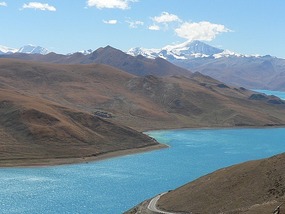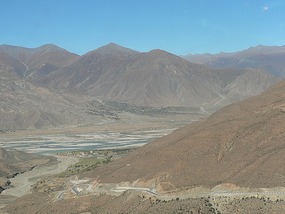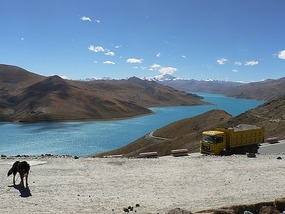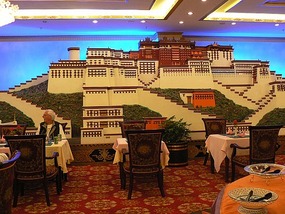Our scheduled trip to Yomdrok Lake was reversed as the road there was blocked on our forward journey to Gyantse. So from Shigatse we detoured to visit the lake on our return trip back to Lhasa.
We travelled back via the Sacred Mountain we had passed on the way to Gyantse. An eerie sight, a thin quill of smoke emanated from the top of the mountain and in the far smoky distance of the summit we could just make out a surreal gathering of people. Lochoe explained that this was a "funeral" service and we agreed that we were fortunate to see it. Overhead loomed a number of large birds of prey, presumably the vultures. Chills crept up my spine.
Once again we had lunch at the Tibetan cafe we had visited on our journey to Gyantse. Again the food was excellent and we enjoyed the snug setting and welcoming atmosphere of this strange little cafe perched high up on a lonely mountainside in the midst of nowhere. Mr Yu and Lochoe we noticed ate enormous meals. Mr Yu always ordered Chinese meals whereas we did not ever see Lochoe eat anything other than Tibetan food, usually yak meat, potatoes and or dumplings. They were both very fit and trim. We reasoned the food must be very healthy. But then again they didn't drink beer as we did....
On our way to Yomdrok Lake we travelled up through the immense Gangbula Pass at a height of 4800 meters. Our climb up to the top of this mountain was breathtaking.
The road, although sealed and in good order, was frighteningly narrow with some 2,000 meter (or 2 kilometers!) drops on each side. There were no guard rails, only sometimes some small cement blocks about one foot high - just to let you know you were near the edge. As Alan just said "They sure weren't a barrier". The road up etched a long, snaking and torturous path into the mountain sides. Like a lot of the Tibetan environment we were travelling through treeless arid desert terrain. Which of course meant you could see to the very bottom of the steep scree mountainside.
On reaching the summit we were rewarded with spectacular views of the sacred Yomdrok Lake. As promoted, it was a stunning turquoise vista lying some hundreds of meters below the Pass. Snow capped distant mountains and a brilliant bright azure sky provided a picture perfect frame to this magnificent aqueous jewel. No wonder it is also known as the Green Jade Lake.
Yomdrok is one of the three largest lakes in Tibet (just take a look at a terrain map of Tibet and you can be dazzled by just how many lakes there are). It is over 72 kilometers in length and like most Tibetan lakes, it freezes over in winter. Its depth is unknown. Like mountains, lakes are considered sacred by the Tibetans. Yomdrok is no exception. It is said to be invested with very special spiritual powers and is considered as part of the life-spirit of the Tibetan nation. The lake is home to the famous Samding Monastery, the only Tibetan monastery to be headed by a female re-incarceration and is considered to be the female Guardian of Buddhism in Tibet.
While the views were staggering, it was blowing a mighty icy gale on the summit, making it almost impossible to stand up to take photos. Taking our own photos we soon realised came with more than a gale force wind problem. Immediately we were inundated with a very large group of nomads who made it quite clear that they wanted to be paid for our photographs. They were surprisingly aggressive and obviously very used to dealing with unwitting tourists. There was no way out. Lochoe and Mr Yu had suddenly disappeared from sight and so we paid some ridiculous price to take their photo - which somehow I lost on my camera card.
We were mind blown that at this time of the year these nomads still lived on this hostile mountainside in humble tents with their herds of sheep, goats and yaks. It was hard not to feel pity for them and their harsh way of life. Until that is - on leaving we spotted one stout nomad elder sitting outside his tent counting a huge wad of notes, presumably from other vulnerable foreigners. We drove away amused that we could not find anything other than admiration for their entrepreneurial skills
We reached Lhasa for the last time in the late afternoon, just in time to buy some supplies for the evening and for our rail trip to central China the next day. We spent a relaxing few hours looking for snack food that we could identify - which was virtually impossible. Small supermarket shop owners were wonderfully helpful and friendly and we were amused that we were given a number of sweets instead of small change. We politely refused as we didn't need too much small change but nevertheless they insisted. Throughout our trip we had found Tibetan people to be delightfully friendly and hospitable.
That evening we spent some time talking to the young people who worked in our hotel restaurant.
They were keen to practice their English and we were very impressed with their language skills and their attentiveness to us as guests. They explained that they studied during the long winter when Lhasa virtually closes down. This somewhat surprised us and we could not help but wonder how the tourist industry could exist for just six months or less per year.
Our young restaurant staff was mainly Tibetan and when we asked if they liked Chinese food as well as Tibetan one young woman told us very firmly that she found Chinese food disgusting. "I only eat yak meat and sampa (toasted barely meal mixed with yak butter) and I drink only yak milk and yak butter tea" she maintained. There was no disputing that she was deadly serious.
Returning to Lhasa
Thursday, October 18, 2007
 Lhasa, Xizang, China
Lhasa, Xizang, China
Other Entries
-
1From Crowdy Head to Sydney - Our Journey Begins
Oct 0612 days prior Crowdy Head, Australiaphoto_camera0videocam 0comment 0
Crowdy Head, Australiaphoto_camera0videocam 0comment 0 -
2On the Eve - Our Journey to the Distant Chinas
Oct 0711 days prior Sydney, Australiaphoto_camera2videocam 0comment 0
Sydney, Australiaphoto_camera2videocam 0comment 0 -
3A Brief Return to Our Favourite City of Shanghai
Oct 0810 days prior Shanghai, Chinaphoto_camera5videocam 0comment 0
Shanghai, Chinaphoto_camera5videocam 0comment 0 -
4Our Journey to Zhongdian, via Kunming
Oct 099 days prior Kunming, Chinaphoto_camera2videocam 0comment 0
Kunming, Chinaphoto_camera2videocam 0comment 0 -
5Two Delightful Days in Shangri-la - "Paradise"
Oct 108 days prior Zhongdian, Chinaphoto_camera8videocam 0comment 0
Zhongdian, Chinaphoto_camera8videocam 0comment 0 -
6Mystical Lhasa
Oct 117 days prior Lhasa, Chinaphoto_camera8videocam 0comment 0
Lhasa, Chinaphoto_camera8videocam 0comment 0 -
7Friendly and Not so "Ho-Hum" Tsedang
Oct 135 days prior Tsedang, Chinaphoto_camera16videocam 0comment 0
Tsedang, Chinaphoto_camera16videocam 0comment 0 -
8Rural Tibet - Our Desert Journey to Gyantse
Oct 153 days prior Gyantse, Chinaphoto_camera19videocam 0comment 0
Gyantse, Chinaphoto_camera19videocam 0comment 0 -
9More of Rural Tibet - Our Trip to Shigatse
Oct 162 days prior Shigatse, Chinaphoto_camera4videocam 0comment 0
Shigatse, Chinaphoto_camera4videocam 0comment 0 -
10Returning to Lhasa
Oct 18 Lhasa, Chinaphoto_camera4videocam 0comment 0
Lhasa, Chinaphoto_camera4videocam 0comment 0 -
11Aboard the Lhasa Express - Lhasa to Golmud
Oct 191 day later Golmud, Chinaphoto_camera18videocam 0comment 0
Golmud, Chinaphoto_camera18videocam 0comment 0 -
12Salt Pans, Altun Shan and a Taklamakan Apparition
Oct 202 days later Dunhuang, Chinaphoto_camera6videocam 0comment 0
Dunhuang, Chinaphoto_camera6videocam 0comment 0 -
13Lovely Dunhuang - An Oasis in the Gobi Desert
Oct 224 days later Dunhuang, Chinaphoto_camera16videocam 0comment 0
Dunhuang, Chinaphoto_camera16videocam 0comment 0 -
14Frenetic Liuyuan and our Rail Trip to Turpan
Oct 235 days later Turpan, Chinaphoto_camera0videocam 0comment 0
Turpan, Chinaphoto_camera0videocam 0comment 0 -
15Toward Turpan - Our Welcome to Xinjiang Province!
Oct 246 days later Turpan, Chinaphoto_camera2videocam 0comment 0
Turpan, Chinaphoto_camera2videocam 0comment 0 -
16Tales of Turpan - Second Lowest Basin in the World
Oct 246 days later Turpan, Chinaphoto_camera11videocam 0comment 0
Turpan, Chinaphoto_camera11videocam 0comment 0 -
17Exotic Urumqi - As Far From the Sea as You Can Be
Oct 268 days later Ürümqi, Chinaphoto_camera7videocam 0comment 0
Ürümqi, Chinaphoto_camera7videocam 0comment 0 -
18Twenty Three Hours to Kashgar by Rail
Oct 2810 days later Kashgar, Chinaphoto_camera0videocam 0comment 0
Kashgar, Chinaphoto_camera0videocam 0comment 0 -
19Our Introduction to the Frontier City of Kashgar
Oct 2911 days later Kashgar, Chinaphoto_camera4videocam 0comment 0
Kashgar, Chinaphoto_camera4videocam 0comment 0 -
20A Driver Called Mukhtar - Travels to Tashkorgan
Oct 3012 days later Tashkorgan, Chinaphoto_camera14videocam 0comment 0
Tashkorgan, Chinaphoto_camera14videocam 0comment 0 -
21Kashgar Old City, More Carpets and Abdul Karim
Oct 3113 days later Kashgar, Chinaphoto_camera7videocam 0comment 0
Kashgar, Chinaphoto_camera7videocam 0comment 0 -
22On the Home Run - From Kashgar Back to Urumqi
Nov 0215 days later Ürümqi, Chinaphoto_camera4videocam 0comment 0
Ürümqi, Chinaphoto_camera4videocam 0comment 0 -
23From Urumqi to Shanghai, Sydney and Home
Nov 0417 days later Shanghai, Chinaphoto_camera1videocam 0comment 0
Shanghai, Chinaphoto_camera1videocam 0comment 0 -
24Home In Crowdy Head and A Message to Our Readers
Nov 0518 days later Crowdy Head, Australiaphoto_camera0videocam 0comment 0
Crowdy Head, Australiaphoto_camera0videocam 0comment 0

 Lhasa, Xizang, China
Lhasa, Xizang, China





2025-05-23